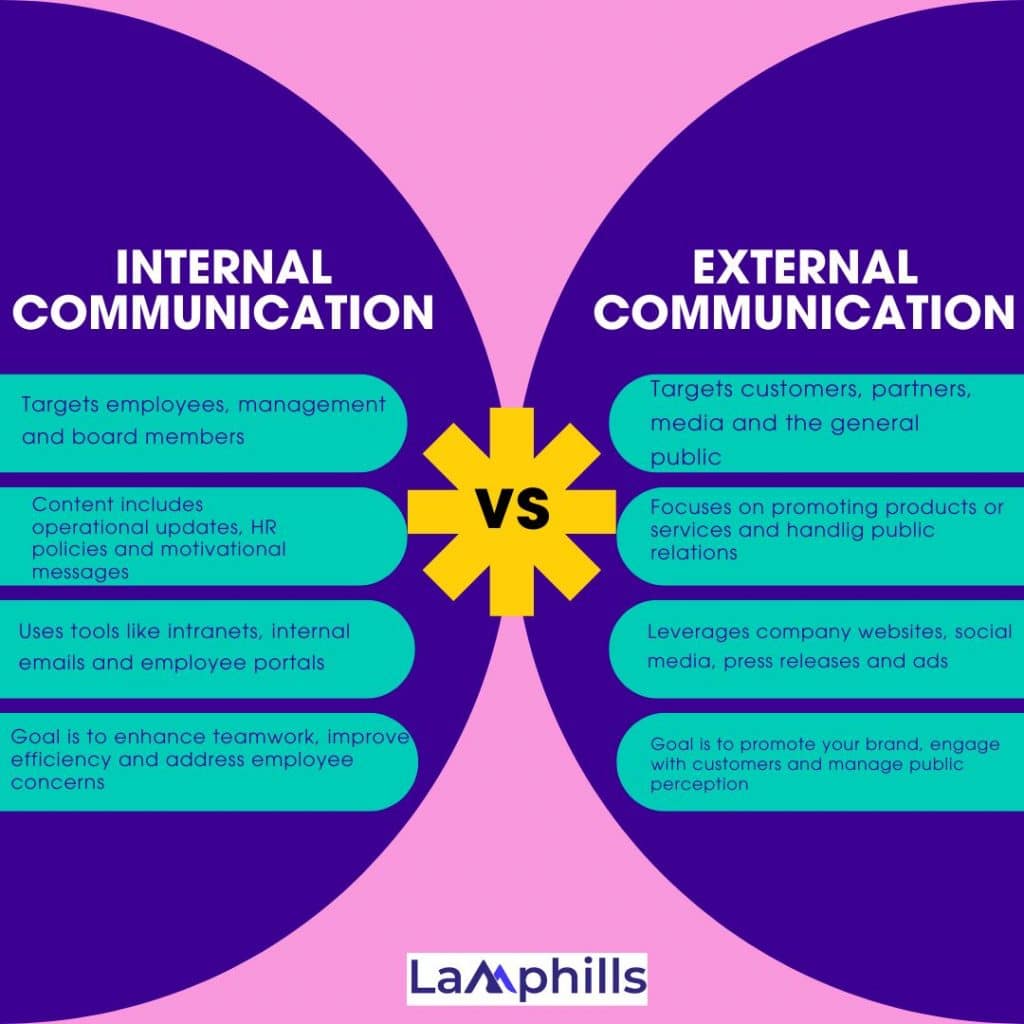In years of writing and consulting, I’ve seen how far communication can go in making or breaking an organization. I had a friend who worked with a promising startup that was revolutionizing the renewable energy sector. They had cutting-edge technology and a passionate team, but they faced significant challenges that threatened their success. One major incident that stood out was during a major product launch; the CEO announced a groundbreaking new solar panel design to the public. However, the internal team hadn’t been fully briefed on the product details, leading to confusion and errors in the information provided to potential clients. As a result, the external message was inconsistent, and the internal team felt blindsided and undervalued. The problem here was clear: there was no proper internal communication structure and it affected the company’s external communication. Here, we’ll evaluate internal vs external communication and explain how both of them work together to achieve success in the organization.
Key Points
- Internal communication is the exchange of information within an organization, while external communication deals with how an organization interacts with external entities and the general public.
- Effective internal communication enhances employee engagement and morale, while effective external communication builds and maintains a positive brand image and ensuring customer satisfaction.
- Internal communication uses tools like intranets, internal emails, and employee portals, while external communication relies on company websites, social media, press releases, and advertisements to reach its audience.
- The primary objectives of internal communication are to enhance teamwork, improve efficiency, and address employee concerns. External communication aims to promote your brand, engage with customers, and manage public perception.
External vs Internal Communication: Definition and Overview
What is Internal Communication?
Internal communication refers to the exchange of information within an organization. It’s the backbone of a company’s operations, encompassing everything from team meetings to internal newsletters. When done right, it aligns everyone towards common goals and fosters a positive work environment. Think of it as the glue that holds the organization together, ensuring that everyone is on the same page.
What is External Communication?
On the other hand, external communication deals with how an organization interacts with external entities like customers, partners, and the media. It includes marketing materials, press releases, social media posts, and customer service interactions. The main objective here is to build and maintain a positive brand reputation while engaging effectively with the broader community.
Internal Communication and External Communication: How are they Similar?
Before we go to the differences between these two forms of communication, let’s look at their similarities:
#1. They both have a sender and a receiver
It’s common knowledge that communication involves the sender of the information and the receiver. These two may differ depending on the form of communication; for internal communication, the parties involved are the staff and organizational bodies in the organization, while external communication is between the organization and the members of the public.
The sender-receiver role swap is particularly important, especially in external communication, where the emergence of digital media has enabled receivers of organizational communications to adopt a more active role, thus converting external communication into a bidirectional channel.
#2. There’s a transmission channel
Of course, internal and external communications must both have a channel to transfer the message from sender to receiver. Internal communication channels may range from mere verbal communication when dealing with face-to-face talks to any digital support such as an intranet.
External communication is similar in that. Mass media can also be used to achieve a broader dissemination of the message, though usually at an elevated cost. However, the relentless progress of digitization has also enabled the segmentation of receivers at levels virtually unimaginable only a few years ago, so that we can now personalize messages to get the desired reaction or influence in each case.
Internal vs External Communication: Key Differences

Internal and external communications both work to ensure the smooth running of the organization. However, their methods differ. Here are some of their key differences:
#1. Audience
Internal communication targets employees, management, and board members. It’s all about ensuring that your team is informed, motivated, and working efficiently. In contrast, external communication is aimed at customers, partners, media, and the general public. The goal is to project a consistent and positive image of your company to the outside world.
#2. Content
The content of internal communication includes operational updates, HR policies, and motivational messages. For instance, regular updates about company goals and achievements can boost employee morale. External communication, however, focuses on promoting products or services, managing brand image, and handling public relations. This might involve launching a new product or addressing customer concerns on social media.
#3. Channels and Tools
Internal communication uses tools like intranets, internal emails, and employee portals. These tools help to facilitate seamless information flow within the company. External communication, however, relies on company websites, social media, press releases, and advertisements to reach its audience. Each platform requires a tailored approach to ensure the message is effective and engaging.
#4. Objectives
The primary objectives of internal communication are to enhance teamwork, improve efficiency, and address employee concerns. This fosters a cohesive and productive work environment. Externally, the goals are to promote your brand, engage with customers, and manage public perception. Effective external communication can drive sales and build long-lasting customer relationships.
Internal Vs External Communication: Their Benefits

Internal Communication
Effective internal communication enhances employee engagement and morale. When employees feel informed and valued, they are more likely to be productive and loyal. It also facilitates better decision-making and problem-solving by ensuring that everyone has the necessary information. Furthermore, it promotes transparency and trust within the organization, which is crucial for a positive workplace culture.
Here are some key benefits of internal communication:
#1. Aligns departments
Internal communication enables departments to collaborate effectively and efficiently, ensuring they’re all working towards the same goal, schedule, and budget. This is beneficial in all organizations, especially in scenarios where multiple departments work on a single project.
#2. Improves operations within human resources (HR) departments
Effective internal communication aligns employees with the organization that they work for. HR departments are usually responsible for daily internal communication with management and staff, and effective communication is key to streamlining HR operations. HR teams are tasked with listening to staff concerns, communicating company goals and rules to staff members, and looking after employee well-being. Good internal communication skills can help you to carry out these responsibilities successfully.
#3. Aids problem solving
Internal communication skills can help organizations to solve problems more efficiently and effectively. By improving how different departments and specialists within a company communicate with one another, you can empower staff members to share problems and benefit from each other’s skills and knowledge. This can improve problem-solving within an organization and simultaneously boost innovation and creativity.
External Communication
On the external front, effective communication builds and maintains a positive brand image. Engaging customers through various platforms can drive loyalty and increase customer satisfaction. It also plays a critical role in managing public perception, especially during a crisis. A well-handled crisis can even strengthen a company’s reputation, demonstrating its commitment to transparency and customer care.
Here are the key benefits of external communication:
#1. Increases brand visibility
External communication is the only way to get customers to notice a company’s products and services. Companies use external communication in the form of marketing and advertising to spread brand visibility and promote their services to customers. Effective external communication helps marketing departments market your brand to customers, increasing sales and conversions and boosting positive associations with your brand.
#2. Allows organizations to reach new customers
External communication also helps companies to reach new customers. Thanks to the internet, companies willing to invest in external communication can reach new audiences and gain visibility on a potentially global scale. If you want to expand your business and increase its reach, you should leverage external communication.
Read Also: How To Measure Reach: Effective Tools and Strategies
#3. Brings new information into an organization
In addition to sending out information, external communication enables organizations to get new information. When your organization consults external experts, such as specialists and consultants, they can bring new skills and ideas into the organization (which your staff can then share between themselves using internal communication skills). In this way, external communication is useful because it helps your organization increase the knowledge it holds.
Best Practices To Ensure Effective Communication
Internal Communication
Here are some tips on how you can improve the internal communication in your organization:
1. Encourage Open Feedback: Create an environment where employees feel comfortable sharing their thoughts and concerns.
2. Use Multiple Channels: Different employees may prefer different communication methods. Utilize emails, intranets, and face-to-face meetings to ensure everyone is reached.
3. Regular Updates: Keep employees informed about company goals, performance, and changes. This helps them feel connected and valued.
In a previous role, I worked with a company that implemented a bi-weekly “All Hands” meeting where leadership shared updates and invited questions from employees. This practice significantly improved transparency and trust within the team. Employees felt more connected to the company’s mission and were more engaged in their work.
External Communication
1. Consistency: Maintain a consistent brand voice and message across all platforms. This builds a strong and recognizable brand identity.
2. Engage on Social Media: Actively engage with your audience on social media. Respond to comments, share valuable content, and build a community.
3. Proactive Crisis Management: Be prepared for potential crises. Have a plan in place and be ready to communicate quickly and effectively.
A memorable example of effective external communication was when a client of mine, a health and wellness company, launched a new product line. They used a well-coordinated campaign across social media, email newsletters, and PR releases. The consistent messaging and active engagement with their audience resulted in a successful launch and increased customer loyalty.
Connecting Internal and External Communication
To ensure maximum productivity in your organization, It’s important to understand how internal and external communication connect. You could run some training sessions on communication skills for your staff. This can aid communication across the organization and ensure that all team members communicate valid and reliable information clearly, confidentially, and efficiently. The following tips can be helpful:
Remember that third-party communications can also affect the brand
Communication from third parties, including customers and other companies, can significantly influence your organization’s branding and message. When you’re planning external communication strategies, it’s good to factor in how your organization reacts to external communications posted by third parties, such as poor online reviews.
Read Also: Interactive Facebook Posts: Level Up Your Marketing Strategy
Make sure your internal and external communications align
It’s advisable to ensure that your internal and external methods of communication align, even if the mode of delivery for each is different. For example, internal and external communications share the same brand message and mission. So, if the external message focuses on eco-friendly products and services, the internal message should reflect this focus too.
Incorporate storytelling
Whether you’re communicating with your colleagues internally or communicating with customers externally, you can improve the effectiveness of your communications by telling a story. Stories engage listeners and help them to follow the point you’re making. Storytelling is a simple way to make your communications clear and compelling to all audiences.
What Is The Difference Between Internal And External Barriers of Communication?
Internal barriers to communication are obstacles within the organization, such as unclear messaging, lack of trust, or poor organizational structure. External barriers come from outside the organization, like cultural differences, language barriers, and external noise or distractions.
What Are Examples Of Internal and External Barriers?
Internal barriers include poor communication channels, lack of transparency, and low employee morale. External barriers encompass market competition, regulatory changes, and negative public perception. Both hinder effective information flow and organizational success.
In Conclusion
Both internal and external communications are important for your company’s success. While they serve different purposes and audiences, their effectiveness directly impacts an organization’s performance and reputation. By understanding the key differences and implementing best practices, businesses can ensure they communicate effectively both within and outside their walls.
Related Articles
- How Does Internal Communication Contribute to Your Business Success?
- External Communication In Business: Strategies for Amplifying Your Business Voice
- Public Communication Tips You Should Know in 2024
- The Top 10 Communication Agencies in Nigeria You Should Know





